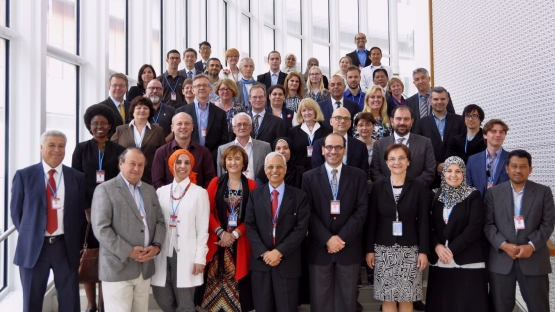A Technical Meeting on Patient Dose Monitoring and the Use of Diagnostic Reference Levels for the Optimization of Protection in Medical Imaging was held at the IAEA headquarters on 30 May - 3 June 2016. More than 60 professionals from 35 different countries and 8 international organizations and professional bodies participated in this meeting.
The focus of the meeting was to understand the current situation, identify strengths and weaknesses in ongoing practice and in using diagnostic reference levels (DRLs) for optimization of patient safety and improving medical practice.
Participants demonstrated good examples of well-organized dose surveys, coordinated either by the national authorities or by the initiative of professionals ("champions"). Some countries have already established dose index registries for automatic or web-based data collection, many others still use paper-based data collection approach. Ongoing efforts and research are focused on the best use of dose management systems already available in many hospitals and countries. Networking globally provides an effective support in this field.
The IAEA actions and support were identified as critical for many countries in establishment of a methodology and starting with dose data collection and evaluation. Participants discussed good practices in establishing cooperation between authorities and professional societies or clinical experts for surveys and DRL setting and periodic stakeholder DRL reviews. Regulatory inspections were also identified as a key element in proper use of DRLs.
Based on the analysis of weaknesses and challenges, the meeting identified possible solutions and actions needed, grouped around six main points:
Human resources: Actions are needed to:
- guarantee sufficient involvement of medical physicists in diagnostic imaging and their recognition;
- improve availability and radiation protection knowledge of radiologists and nuclear medicine specialists;
- strengthen the motivation and involvement of radiographers in patient dose monitoring.
Training of medical staff is critical in understanding the use of dose monitoring and DRLs, the role and responsibilities of each profession on dose reduction technics, image quality assessment and interpretation, risks and benefits. Specialised training is needed for regulatory officers on the concept of optimization using dose monitoring and DRLs.
Safety and quality culture: Actions are needed to:
- improve awareness on importance of justification and optimization and recognition of the value of team work and holistic strategy;
- increase the contribution of professional societies;
- encourage accountability, improve motivation of health professionals, develop and use means of collaboration.
There is a need to improve government's and leaders' awareness on importance of radiation protection in medicine, to increase competence and increase coordination between authorities. Providing public communication is important.
Regulations: There is a need to:
- establish or improve legislation and build up infrastructure for radiation protection, including optimization;
- enforce employment of medical physicists in diagnostic radiology facilities; increase resources/staff of authorities;
- increase human capacity.
Patient dosimetry, DRLs and quality assurance should be mandatory.
Funding: Lobbying and giving motivation to governments for funding; increase micro funding.
Tools and methods: The following actions needed have been identified:
- establish national program for DRLs, from setting DRLs to implementation;
- establish sustainable system to enable frequent updating of DRLs;
- establish mechanisms for dose collection and reporting;
- improve standardization of classification systems for medical procedures;
- provide dosimetry equipment and improve calibration and quality control;
- improve strategy of DRLs, specificity to indications and patient size;
- develop image quality analysis techniques and implementation.
Big data is a challenge, needs improved patient exposure data management by using electronic automatic systems, preferably integrated with general electronic health record systems; data validation systems have to be introduced and maintained. Hospital based local actions in some countries need to be translated to nationwide actions. Cooperation across countries should be promoted.
The meeting also discussed advanced concepts for optimization, promoting a move from reactive optimization to proactive optimization actions. Patient-centric approach for optimization should be supported, with review of indication based clinical protocols. Develop concepts to better account for image quality, starting with acceptable images. Individual dose tracking provides opportunities to strengthen optimization of patient protection, as patient acts as self-control for comparison between techniques and facilities. Develop concepts to include risk consideration, balance radiation risk and clinical risk. Promote development of new IT standards to expand to organ dose calculation. For patient centric approach, promote setting trigger levels for image guided interventional procedures and reporting abnormal doses.
Special focused sessions presented and discussed the role of international organizations, national professional societies and the role of manufacturers of medical equipment and software.


